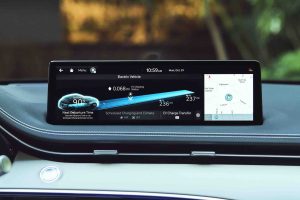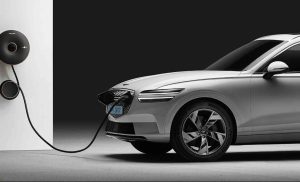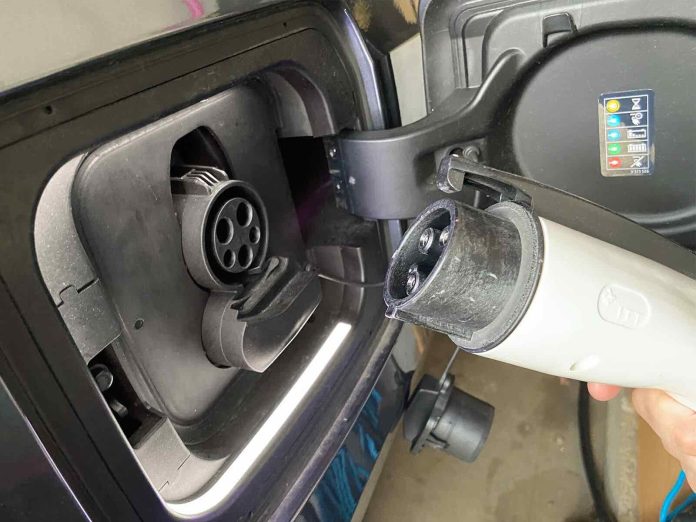We’ve all heard about the range/recharge issues with EVs. But there’s a related issue that’s not often discussed that probably ought to be.
It is the location issue.
Like most people who don’t live in or near a major city, I live about half an hour’s drive away from the nearest commercial “fast” charger. That would have several negative consequences for me, if I were to buy an EV.
And perhaps for you, too.
The first, obviously, is that I’d have to spend 30 minutes to get to the “fast” charger – where I’d then have to wait at least another 20-30 minutes to recover a partial charge. This assumes I don’t have to wait for someone else to finish waiting, as there are only so many “pumps” available. This access problem will become a more obvious problem as the number of EVs increases in relation to the number of “pumps” available to charge them.
Anyhow, there goes an hour spent “fast” charging – best case, assuming I’m first in line.
People who live close-by to “fast” chargers can reduce the time spent getting to and from these chargers – but those who don’t can’t.
They can charge at home, of course.
But that’s far from “fast.”
That’s because few, if any, private homes have the capacity to “fast” charge an EV.
Most don’t even have the capacity to partially recharge them in several hours – as this requires a dedicated 240V circuit such as the ones many homes have for electric dryers and stoves. The problem is these are inside the house, usually – and also they’re usually already in use. To use them to charge the EV would mean unplugging the dryer or the stove and not using them while the EV is charging.
Assuming the charge cord is long enough to reach from the EV to inside the house, where the 240V outlet is.
If not, an electrician will have to be summoned – and paid – to wire up a new (and dedicated) 240V circuit in the garage, for the EV.
More on this in a moment.
If the existing electrical panel cannot handle an additional 240V circuit and the load it will impose on the panel (e.g., when the EV is charging and the clothes dryer is running) or it’s too expensive to hire an electrician to upgrade the panel and wire the circuit, then you’ll have to rely on ordinary 120V household current to charge your EV. And the problem there is it takes more than all day to impart even a few miles of range into an EV.
As an example, I plugged in a ’24 Genesis GV70 EV I have just spent a week mostly not driving at around 12:30 on a Tuesday afternoon, with about 52 miles of indicated range remaining.
The next morning, the dash display said the EV had 68 miles of range – a gain of 16 miles over the course of about 18 hours. That’s just about enough range recovered to make it to the “fast” charger downtown. But not enough to risk not stopping there – and waiting the minimum of 20 minutes Genesis says it takes to recover a partial charge – before heading back home.
This brings us back to the location problem.
Because I am not located near a “fast” charger, I have to stay home and wait for the EV to charge – or spend time driving to the “fast” charger, to wait there. Either way, I spend time not driving. If I drive – to the “fast” charger – I arrive there with less charge – and so, range – than when I started. By the time I get back home from charging, I have less charge (and so, range) than I had when I left the “fast” charger.
The point here is it’s not easy to keep an EV charged up, if you don’t live near a “fast” charger. You are almost always driving around with a partially charged EV. And the problem there is you cannot drive a partially charged EV very far.
Or very often.
I’ll use the ’24 GV70 EV as an example, again. When it was delivered for my week-long test drive, it only had about 170 miles of range remaining – rather than the maximum 236 miles it has when fully charged – because it was partially discharged by the time it was left. That was unavoidable because the nearest “fast” charger is – once again – about 30 minutes away. Even if the delivery driver had had the time to fully charge it there, by the time he drove it here, it had lost about 60 miles of its fully charged range.
If I’d plugged it in right then – and so not driven it – by the next day, I could have recovered some (but not much; more follows) of the range it lost driving here. But the cost of that would have been me not being able to drive it in the meantime – contrary to the purpose (ostensibly) for which it was built and the reason why it was sent to me. So I drove it, instead. By the time I got done driving into town and back, it only had about 105 miles of range left, enough – just maybe – to drive it one more time, leaving enough of a margin to get back home . . . and plug it back in.
But because my house lacks a 240V outlet in the garage, all I could do was plug it in to a 120V outlet – and wait. For the next two days. That’s how long it takes – on 120V to recover about 40 miles of range.
In the meanwhile, no driving.
Hence part-time vehicle.
Of course, I could install the 240V “Level II” circuit and then I’d be able to drive the EV every day, by leaving it to charge overnight.
Don’t most households have two cars? Don’t many have three? One for the husband – another for the wife? How about one (at least) for their teenaged kids? This is the typical arrangement and has been so for generations.
Well, consider the implications.
If – as we are led to believe – “electrification” means replacing one-for-one every vehicle with an electric vehicle, how will they all “Level II” charge at once, if there’s only one 240V place to plug in at home?
The answer is – they won’t.
While most home electrical panels can accommodate an additional 240V circuit, few can accommodate several – which is what would be needed to allow for a family to operate multiple EVs as daily drivers. The load would be too great – and the cost too high – to make it not.
Ergo, what will happen – if this push toward “electrification” isn’t halted – is that most households will have one community EV that everyone shares. Priority use will, of course, go to whomever the breadwinner is. The rest of the family will likely have to hitch a ride or hoof it to wherever they need to be.
Add to this mix the economics of having to buy multiple EVs to replace the cars currently in service. Given the average price paid for a new EV this year is nearly $50,000 that would mean the average family would need to spend at least $100k for two – plus the two 240V circuits that would be needed to avoid one of the two being a part-time vehicle.
It’s all untenable – and meant to be.
Because the point of all this isn’t to replace existing vehicles on a one-for-one basis with electric vehicles.
It is to dramatically reduce the number of vehicles – and driving, too.
. . .
If you like what you’ve found here please consider supporting EPautos.
We depend on you to keep the wheels turning!
Our donate button is here.
If you prefer not to use PayPal, our mailing address is:
EPautos
721 Hummingbird Lane SE
Copper Hill, VA 24079
PS: Get an EPautos magnet or sticker or coaster in return for a $20 or more one-time donation or a $10 or more monthly recurring donation. (Please be sure to tell us you want a magnet or sticker or coaster – and also, provide an address, so we know where to mail the thing!)
If you like items like the Keeeeeeev T shirt pictured below, you can find that and more at the EPautos store!














OK so riddle me this:
Isn’t there supposed to be some concept around ridesharing and community self-driving cars, so the car spends more time being driven and less time just parked? Like this is supposed to be a more efficient way of doing things, and if you own one you can use it to make money like Uber on steroids?
Does anyone else remember that?
Well, how the h-e-double-hockey-sticks is *that* supposed to work when the vehicle has to spend all of its time tethered to a charger? Explain that one to me…
Hi Publius,
That’s easy!
Once you understand that “electrification” is about reducing the number of cars on the road – and the number of people driving them – it all makes perfect sense. It only seems perplexing when you operate from the assumption that all they’re doing is trying to force a “transition” to “clean” cars.
Porsche is trying to keep ice cars alive and keep the existing ice cars on the road….
They are planning on selling a new hydrogen burning ice engine and efuels to keep the current ice vehicles on the road……
efuels at $44.00 per gallon…so just the rich will keep driving their ice vehicles….
https://www.youtube.com/watch?v=sLdwtwdDFGQ
Hey if it gets too desperate for petrol, how about a blast from the past!
Got chainsaw will travel:
https://www.resilience.org/stories/2010-01-20/wood-gas-vehicles-firewood-fuel-tank/
I’m wondering if our sovereign tribes will finally say FU to the Feds and build the refineries they talked about several years ago. Here in Central WA they operate stations on tribal land, Yakima Nation (they have their own license plates too!)
https://kimatv.com/news/local/people-are-commuting-to-yakama-nation-to-pay-less-at-the-gas-pump
Did she say the quiet part out loud?
https://twitter.com/ElonMuskAOC/status/1680321369475805184
In agreement w/ MarkyMark below re: installing your own home charger, I would definitely write that off. If you don’t have 30 amps spare that is a far bigger issue and not cheap.
The charger itself out where you are done by a professional installer shouldn’t run you more than about $1000-1500. DC is crazy expensive and mine was under $1500 including the charger unit itself though some of my less wise neighbors have paid way more than that because dumb liberals often have money to burn. If you don’t have 30 amps to spare that business write down is going to be WAY more expensive as they are having to add capacity to your breaker box. That’ll be another 10-20K depending.
The bigger challenge for you would be that you test multiple -types- of EVs and once again, this unveils another problem with EVs not often discussed. Complete lack of standardization! You’d be taking a gamble for that reason alone sadly unless you want to have a row of different chargers lined up on your wall which is absurd.
Tesla has their proprietary connector, you can get adapters, yes, but its a hassle and they don’t work on older cars. Visa-versa same issue, you cannot charge older Teslas on non-Tesla fast chargers.
There are at least 3 main EV connectors right now and its a crap shoot if you can charge at any that aren’t built for your specific plug with an adapter. Tesla is the 800lb gorilla, then there are 3 other major types. CHAdeMO, CCS, and J1772. If this sounds absurdly confusing, that is because it is!
https://evcharging.enelx.com/images/blog/enel-x-way-plug-types-font-blog.jpg
There is a diagram of the major plug types. This is typical of the way things are done today. A functional society would plan the infrastructure in advance with a –universal– plug design. But we are not a functional society anymore.
Imagine going to fuel your car and there are 3-4 different nozzles for gas. Only one nozzle fits your car type. Sound like fun? This is the world of EV charging as it stands today.
THanks, User!
I have a 30A outlet in my shed/workshop that I could readily use as it’s already wired – for a welder. But – as you’ve explained – the problem there is it might be good for just one make of EV and I test drive pretty much all of them. This raises an issue I wish I had in the article, which is that a household may need to buy/install two different types of 240V plugs in order to Level II two different brands of EV. Many households have more than one brand of car (non-electric). This plug problem will make it harder for households to do that.
Thanks again for the very useful info!
The new to me news in the fight against government forcing BEVs and ending automobiles for all but the wealthy is that despite investor pressure, the new Toyota CEO is in some good measure continuing the fight. Toyota is working on an ICE that burns ammonia. No carbon. None. It’s nitrogen and hydrogen. This is where the control freaks will have to admit that it was never about CO2. BEV’s often get their electricity from burning hydrocarbons but an ammonia engine is zero CO2. There’s no carbon to combine with oxygen. The only CO2 that comes out is the CO2 that went in. (unless of course the air is thick with unburned hydrocarbons which means it’s cleaning the air)
According to the report I saw they are getting 161hp out of a 2L four directly burning liquid ammonia. But some suspect that the engine may use a tiny amount of gasoline or diesel to light it off. That’s 1990s level of hp per L and good enough for me not have to deal with a BEV. Although diluted household ammonia won’t run it and then there could be an issue without fuel stations carrying it.
RE: “there could be an issue without fuel stations carrying it.”
Seems like it could be easily rectifiable enough, as I’m sure you know, portable ammonia tanks & storage tanks are all over the place in the crop producing States. …Or, is that not the right kind of ammonia?
Sure does sound interesting. New to me, too.
It should be the same commercial / industrial grade. I knew about the tanks out in farm country but that had slipped my mind. Most of the farms I used to go by no longer exist or have been consolidated.
Hi Brent,
Saw an article on Toyota’s NH3 engine last week.
Probably the biggest drawback to an ammonia engine is the energy density issue. Ammonia has roughly 1/3 the energy density of gasoline (41,700 BTU/gal vs 114,100 for gasoline), so a car would need a fuel tank 3 times larger to provide the same driving range.
Of course, this assumes the (bogus) need for a non-CO2-producing engine in the first place.
Eric,
Could you install a Level II charger in your home, and write it off as a business expense? After all, it seems like it would be necessary to enable yourself to drive the EVs you review. When using 120 VAC to charge them, it seems like the EVs you review spend most of their time sitting in an effort to recover some range. How can you render a meaningful review of a vehicle unless you drive it under many conditions and in many situations? How else can you tell your readers how it is to live with a vehicle day to day?
Then, that begs the question: even if you had a Level II charger installed, would it WORK with all the EVs you test? EV charging connectors aren’t quite standardized yet, so one charger may not work with a particular EV you have that week. So, does that mean when an EV owner changes cars, that he has to change his home charger too?
Hi Mark,
I could run a 240V outlet from the panel in the basement up to the garage – and probably will at some point. But I thought it would be worthwhile to show people just how slowly an EV charges on 120V.
My two-Tesla neighbors have a solution for this when they need to charge two cars. One Tesla is plugged into the wall, while the other charges from a sizable portable generator. It stinks up the area when that thing runs because generators don’t have catalysts of anything.
‘Because I am not located near a “fast” charger, I have to stay home’
The nugget.
That is the objective for these demons
You mention that:
“ Most don’t even have the capacity to partially recharge them in several hours – as this requires a dedicated 240V circuit such as the ones many homes have for electric dryers and stoves. The problem is these are inside the house, usually – and also they’re usually already in use. To use them to charge the EV would mean unplugging the dryer or the stove and not using them while the EV is charging.”
My 1940s house once had oil heat, an electric stove, an electric dryer, and an electric water heater. So I already had three 220 volt lines.
I switched to a natural gas stove and natural gas water heater when I bought the house. The furnace was already switched to natural gas some time in the 70s.
When it was time for a new furnace, I also added central air conditioning. I used the 220 line from the water heater for the air conditioner.
Had I had an electric stove and water heater, I would have had to upgrade my electrical service to handle another 220 line.
Which reminds me: the push for “Elektrifikatsiya” of our vehicles is on a collision course with the push for “Elektrifikatsiya” of our homes.
We are basically moving toward becoming dependent on a single source of energy for our homes and vehicles, not to mention our businesses. This makes us incredibly vulnerable in many ways: from spikes in the price of electricity to brownouts and blackouts to accidents and even attacks on our power grid.
And to make matters worse, we don’t seem to be doing anything to increase our generation capacity, harden our power grid, or diversify our energy supply. We are, for example, totally ignoring nuclear energy, even though it’s the only energy source capable of generating the kind of electricity we’re gonna need.
The refusal to harden the grid against a CME is yet more proof of the real intent.
The goal is control and energy poverty. It’s the only reason for this idiocy that makes any sense. The people at the top who started it and push it aren’t prone to the emotional/social nonsense that their underlings and the useful idiots are so there must be an underlying agenda that makes sense, for them.
RE: “blackouts”
There’s tornado/hurricane season,… and in Winter with sub-zero temps, when the power gets knocked out by ice storms or similar for a week, two weeks,… or a month. No way would I ever want an EV.
I’ve read that electric water heaters last much longer than gas fired ones, in spite of that, because of power outages a.k.a. blackouts, I’m sticking with a gas water heater. The power might be out, but having plenty of hot water can make a world of difference.
Even If I had hot water, I cannot imagine sitting at home for two weeks, or a month, because I couldn’t charge my EV.
And, sure as shit, most people would get fired from their jobs if they stayed home that long.
“incredibly vulnerable in many ways” – indeed.
“While most home electrical panels can accommodate an additional 240V circuit, few can accommodate several – which is what would be needed to allow for a family to operate multiple EVs as daily drivers. The load would be too great – and the cost too high – to make it not.”
Yes, and even if your electrical panel is capable of supporting that … watch that meter spin!
Its crazy….I have a house from the mid 50s and it has no 240v anywhere, that’s a big upgrade- thousands. Appliances are all gas. I wish it had 240, but only because I want to run tig and stick welders. For now, I have to settle for a garage that throws a breaker when an electric heater, one power tool, and the 120w ‘rough duty’ light is on. Could get an LED light, but those all hurt my eyes since getting a blue laser injury years ago.
My house is from the 1950s. There are two 240V lines. One for the AC put in the 1990s and the other for the old window AC from the late 1960s or early 1970s. The second is located “conveniently” in the dining room on the opposite side of the house from the driveway and features an old style outlet. Updated with a new part in the early 2000s when the fuse box was replaced with a circuit breaker box. The box can handle both at the same time being sufficiently modern, the wires from the pole to the house I’m not sure. They have never been replaced but seem to be heavy enough gauge.
Spent a couple days at the Grand Canyon last week, saw plenty of Teslas running around. We stayed at Base Camp in Flagstaff, several T’s in the lot, no charging at Base Camp, lol.
I guess EV’s are all right if you only need to drive 100 miles or so, and keep it always plugged in at home, with some super charging in between. .
Like John said above, EV’s have no advantage over gas cars, just quicker off the mark. An inconvenient little toy, sort of like motorcycles, except even a motorcycle is less inconvenient than a Tesla. Saw plenty of those sweet bikes, northern Arizona has some sweet drives for motorcycles.
A compact Honda or Hyundai makes more sense than a Tesla, for economics, safety, efficiency, and for “saving the world from climate change”. It isnt the emissions at the tailpipe that matter, it’s how long the vehicle is in operation that matters. My landlord drives a late 80’s ford ranger. Just think of the amount of emissions saved by him keeping the same vehicle instead of buying 6 or 8 new ones in the interim.
I dont suppose a Tesla will ever last as long as my Hyundai Sonata, already 16 years old with all the original parts still going strong. I think it retailed for under $15 thousand when new. I’m saving the planet, who knew?
Its the forcing, as Eric says, it’s the forcing out of perfectly good cheap transportation in favor of overpriced vanity projects. Like Gresham’s law, bad money forces out good money. Everyone is holding on to their ICE vehicles and sequestering them for the uncertain times ahead.
One of my girlfriends lives in La Crescenta, CA. Her local gas fillup hit $6 a gallon a couple weeks ago. She wanted to buy a battery car, but after discussing it with me, she is going for a new hybrid instead. Seems to make sense to me, I dont see Los Angeles gas prices ever getting below $5 again, much less $6.
The road to Sunset Crater in Arizona…awesome, smooth and hardly any traffic. I gotta get another bike soon.
Part-time cars for part time people. For any one who has the ability or the means, the time to part company is now, before the party ends.
If a salesman told you the new gasoline car you were looking to buy had to be run to the gas station multiple times in one day AND you would have to spend 3 hours filling it to boot, NO ONE would buy that car. But these EV virtue-signalers will do just that. It astounds me how me people have that much time to piss away tending to a piece of ‘transportation’. EV’s are such an incredible waste of time, money, and resources that their purpose to actually destroy individual mobility becomes clear.
I think that I would be charging that car up outside with a firewall between it and my house.
Anon
What you need with EVs is a detached garage with a walkway that has fireproof doors on each end—or without.
I won’t even park next to an EV, in an open parking lot.
If I remember correctly taxes on gasoline and diesel are what pays for road construction and maintenance. Of course a lot of cities put the money into public transportation (buses, commuter rail, etc.) and not into road maintenance and bridge repair so the infrastructure is rapidly wearing out after decades of neglect.
So what happens when we have half the number of vehicles on the road which also weigh at least a 1,000 pounds more per vehicle without the gas tax revenue to pay for road maintenance? My best guess is roads that fall apart even faster and then .gov taxes everyone in some way even if they don’t own a car or truck.
And that’s why we can’t have nice things. 🙁
Landru, that’s where these proposed MILEAGE taxes come in! Because EVs don’t need fuel to operate, their owners don’t buy fuel, so they don’t pay fuel taxes. Hence, our “leaders” are proposing mileage taxes, so that EVs pay their fair share. Of course, this will help the filthy bastards put us under MORE surveillance! That’s the real reason for mileage taxes, but thanks to EVs, TPTB have a pretext for instituting them.
I think in my state, Ohio, there is a surcharge for EVs, paid with the annual registration. I think it’s $100 extra. That is supposed to replace the lost revenue from the gas taxes the EVs no longer pay.
The question still remains about where the electricity will originate.
A proposal on the Texas ballot this Fall takes some of the state’s budget surplus and establishes a gas generator slush fund which Capo Gecko and others of his ilk will borrow against to build on-demand capacity, but, to qualify for the discount loans, said capacity doesn’t have to be online until 2029.
In the meantime, the state grid comes close to being maxed every evening during temperature extremes as people arrive home, crank up/down the HVAC as need be, and plug in their EVs.
BTW, @Eric, it looks like Elon set a date for the Cybertruck. I still believe it will be EV Waterloo, but, then, what next to advance the agenda?
Evidently, if you boil a potato for eight minutes, connect electrodes, the potato will keep a light emitting diode lit for 40 days.
Just buy a hundred pounds of potatoes and you can have safe lighting for a long time.
Potato Battery
Should be able to maintain the charge on an EV, you won’t need electricity from power plants, potatoes can do the work, joules are what you need. You just need flow of electrons.
Can’t get much greener than that.
China grows 22 percent of the world’s potato crops, so China will be the beneficiary there too.
Plus, double good, you can make a lot of vodka. Win Win Win! Electricity, a fully charged EV, and a desirable libation!
Who can complain?
Buy 200 pounds and eat the other hundred pounds.
But can you still eat the potato when it’s no longer being used as a battery or has it rotted or shriveled up? My best guess is that the cost of buying the potato will be higher the than the value of the energy produced, sort of like how ethanol production uses more energy to produce than what you get as an end product.
I’m pretty sure I’ve said this here before, but nobody should be driving an EV if they do not have a 240v receptacle to charge it.
You’re simply not going to put power into 50-100kwh battery fast enough with a ~1.4kw outlet, especially when you consider losses of any kind, even a very efficient charger and car, to say nothing of it being cold outside. Don’t even think about one of those huge EV trucks. It might take you a week to charge one of those.
A regular 240v 30amp circuit like you might have for your welder in a garage is going to provide 4 times the power of a 120v 15amp plug like you typically see in a house.
I’m traveling this week, in the heart of the rat colony. The hotel where I’m staying has exactly 0 charging stations. A quick maps search shows one “slow” charger about 3 tenths of a mile away. A slow charger is 6000 watts, basically a 30A home charger. Expanding the search shows a scant few chargers, at least for a city the size of Denver (and full of greens too). So if you’re visiting, forget it. You’re going to have to find a charging station, which is going to take a very long time to get to thanks to all the California refugees gridlocking up roads never intended for this level of traffic, then charge at the fastest charger you can find, then if there’s time, get back to business. It will be a hassle. And maybe in a sketchy neighborhood too.
The alternative would be to have the hotel install chargers. Imagine how that might work: There are 180 units in the hotel, assume each of them have a car. If you install 6Kw charging (home/slow) for each car (because you have to plan for the worst case of a depleted battery) it will require 180 pylons and a design for over a megawatt of peak demand. That’s to charge up everyone’s car overnight. Oh, but they won’t all be charging at the same time! Doesn’t matter. Code says design for peak, not average. 150 years of electricity taught engineers that you never assume the best when it comes to power.
A chunk of that Build Back Better™ money is for building out millions of charging stations, because I guess that’s what the public wants from its government. OK, lets assume they can pull that off. To get to a workable scale for travelers, you’d probably have to tear up every parking lot of every hotel in the country. Then hire millions of electricians, make millions of miles of copper cable, and come up with gigawatts of new generating capacity. That’s just to get to a level 2 charger at every hotel. Then, what the heck, do it in every apartment building too. Tear up every parking lot, upgrade every electric service to handle a million watts… again just to get an overnight charge, something that is assumed to be routine. Oh, and do it while the hotel remains in operation (or heck, just add that in too and cut every employee a PPP check so they don’t run off and get another job). Or install a few fast chargers and assume everyone will stick to the schedule. I know what will happen, and I also know that people will be out at 3:00 am recharging their cars.
How is that ever going to be planned? But the dictator’s follies need to be addressed so of course someone will try. After removing labor and capital from productive work, there might be a few cities that have a few neighborhoods that are as I describe.
I stayed at a hotel with charging stations in, so help me, Lancaster, Pennsylvania!
One per room? Because ideally that’s what the future looks like. Every vehicle an EV, every vehicle needing a nightly charge.
The only thing EVs can do that ICVs can’t is accelerate rapidly. Which is not a practical advantage. Location of charge stations, available grid capacity, charging times, and expense are EVs’ practical disadvantages. Which means nothing to the Psychopaths In Charge, because they have already decided you shouldn’t be driving anyway. Which is why there’s been no effort to increase grid capacity to accommodate a significant increase in replacing ICVs with EVs. First they wreck the economy with inflation, and then roughly double the cost of driving. Sounds like a plan.
I’ve already posted in other threads how any given residence would have to be extensively re-wired to reasonably accommodate EV charging with at least a whole new 220V, 100 Amp circuit, which would be minimal. A 480 V, 3-phase, 4-wire setup is far more efficient, but that’s almost NEVER found in any residential development. Maybe in the former Chief Grifter’s, Barrack Hussein Obama and “wife” Michael’s “compound” on Martha’s Vineyard.
It also begs the question of how the “Grid” will supply an extra 22 kVA per HOUSEHOLD of available power, let alone satisfy demand which will presumably hit during “peak” consumption in the weekday evenings. Some form of “smart” rationing? That’d also beg the question of WHO shall control the “rationing”, and on WHAT “criteria”? Somehow, methinks those that presume to “control” US won’t pass up on an opportunity to grab us by the proverbial “short hairs”!
Ludicrous to say residences need a 100A, 240VAC circuit for EV charging.
A 30A, 240VAC dryer outlet allows continuous 24A charging which will recharge a mass-market (~200 miles real-world range) EV overnight.
Use a smart plug like this one to meet code requirements:
https://www.amazon.com/NeoCharge-Amp-Smart-Splitter-Electrician/dp/B09QPMHGX1
Bill in NC, defending EV’s?
…Saying it’s, easy peasy?
It’s, “only” ~$300 Bucks to get the sthmart plug, he says.
On top of how many Dollars to get A 30A, 240VAC dryer outlet to the garage, X2, or 3? …Or, 4?
…Perhaps, I’m going too far & you’re just using electricians math to prove a voltage point, ‘er sumthin’?
…Either way. Still.
Well, you could skip the smart plug if you don’t care about code compliance.
100ft of 30A, 10 gauge generic Romex is ~$250… probably wouldn’t need more than that.
$50 for a heavy-duty outlet like the Bryant 9450fr.
Questions for you, Eric.
As a business do you not write-off the cost of gasoline you buy for other test vehicles? If so, how do you write-off the electricity you provide to charge an EV at home?
Also, if one uses an EV for their business (if that’s all we’ll have available in the future), how can you get an accurate cost analysis of charging the EV vs. gas receipts from Exxon?
Morning, Mark!
It will probably require a means of separating out the cost of charging the EV from your home utility bill; I gather there are ways to do this but I am not hip to them.
I suppose you must get the “smart meter” from your local electricity monopolist. At least that is what the new commercials on the TV are telling me from National Grid – “control your budget easy!”
‘How will they all “Level II” charge at once, if there’s only one 240V place to plug in at home?’ — eric
It’s a rich dilemma, is it not?
Replacing electrical appliances with gas-fired ones is the easiest way to free up 240-volt circuits. But the EPA, and communist coastal regimes, abhor gas appliances and are now banning them as anathema.
A former 240-volt dryer circuit in my house is available because a gas-fired dryer replaced the plug-in one. Then I switched the electric stove for a gas-fired stove which still works even when our crappy electrical grid conks out, freeing up a second 240-volt circuit.
Indeed, I could go one further and replace the veteran electric water heater (38 years old, and still cheerfully perking) with a gas-fired unit, and pry loose yet a third idle 240-volt circuit.
Unforeseen consequences these are, from a regulatory perspective. Push in here; something bulges out there. Mandate EeeVees, but suck more energy because propulsion batteries are a thousand-pound millstone to flog down the road.
Maybe our head-up-ass commissars should just butt the f*ck out.
But they want you to stop using your “polluting” gas appliances too.
Though it’s made us what we are, and we all have an affinity for it, fire places, candles, etc., the Psychopaths In Charge apparently hate fire.
the Psychopaths In Charge apparently hate fire.
They better get used to it. There’ll be plenty of it where they’re going.
Which is perhaps why they hate it so much.
They SHOULD. But electric power distribution can be more readily controlled. Ask any family in GAZA.
Sure, natural gas can also be likewise controlled, but there’s a huge difference…most “natural” gas (i.e., “Propane and Propane Accessories”) can be converted, if necessary (sometimes the ONLY choice in rural areas not served by gas lines) by LP gas, i.e. “butane” (the “bastard gas”, though easily liquefied at normal temperatures). Probably why the insane push to ban gas appliances.
https://www.youtube.com/watch?v=foWcjWz7pxU
If the flow of gas is disrupted it is a complicated process to get it back up and running again. In 2020 ecoterrorists shut off gas a key locations feeding Aspen CO, requiring a complete purge and repressurization, then technicans had shut off all service at the meters so that pilots could be relit in a controlled manor.
https://www.aspentimes.com/news/aspen-residents-businesses-starting-to-see-natural-gas-come-back-along-with-heat/
BTW: Note that the perpitrators were called vandals and not terrorists.